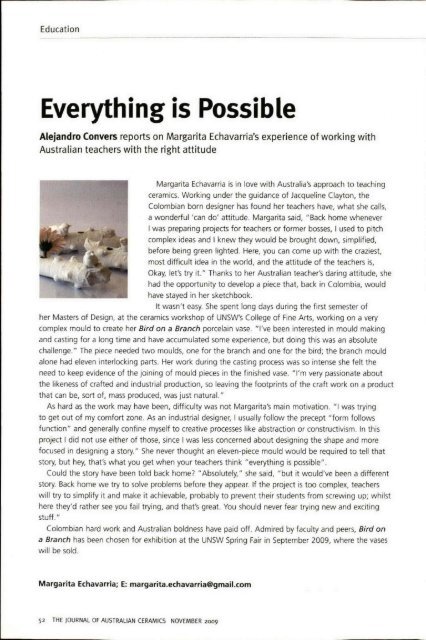The Journal of Australian Ceramics Vol 48 No 3 November 2009
You also want an ePaper? Increase the reach of your titles
YUMPU automatically turns print PDFs into web optimized ePapers that Google loves.
Education<br />
-------~- -<br />
Everything is Possible<br />
Alejandro Conyers reports on Margarita Echavarria's experience <strong>of</strong> working with<br />
<strong>Australian</strong> teachers with the right attitude<br />
Margarita Echavarria is in love with Australia's approach to teaching<br />
ceramics. Working under the guidance <strong>of</strong> Jacqueline Clayton, the<br />
Colombian born designer has found her teachers have, what she calls,<br />
a wonderful 'can do' attitude. Margarita said, "Back home whenever<br />
I was preparing projects for teachers or former bosses, I used to pitch<br />
complex ideas and I knew they would be brought down, simplified,<br />
before being green lighted. Here, you can come up with the craziest,<br />
most difficult idea in the world, and the attitude <strong>of</strong> the teachers is,<br />
Okay, let's try it. " Thanks to her <strong>Australian</strong> teacher's daring attitude, she<br />
had the opportunity to develop a piece that, back in Colombia, would<br />
have stayed in her sketchbook.<br />
It wasn't easy. She spent long days during the first semester <strong>of</strong><br />
her Masters <strong>of</strong> Design, at the ceramics workshop <strong>of</strong> UNSW's College <strong>of</strong> Fine Arts, working on a very<br />
complex mould to create her Bird on a Branch porcelain vase . "I've been interested in mould making<br />
and casting for a long time and have accumulated some experience, but doing this was an absolute<br />
challenge." <strong>The</strong> piece needed two moulds, one for the branch and one for the bird; the branch mould<br />
alone had eleven interlocking parts. Her work during the casting process was so intense she felt the<br />
need to keep evidence <strong>of</strong> the joining <strong>of</strong> mould pieces in the finished vase. "I'm very passionate about<br />
the likeness <strong>of</strong> crafted and industrial production, so leaving the footprints <strong>of</strong> the craft work on a product<br />
that can be, sort <strong>of</strong>, mass produced, was just natural."<br />
As hard as the work may have been, difficulty was not Margarita's main motivation. "I was trying<br />
to get out <strong>of</strong> my comfort zone. As an industrial designer, I usually follow the precept "form follows<br />
function " and generally confine myself to creative processes like abstraction or constructivism. In this<br />
project I did not use either <strong>of</strong> those, since I was less concerned about designing the shape and more<br />
focused in designing a story." She never thought an eleven-piece mould would be required to tell that<br />
story, but hey, that's what you get when your teachers think" everything is possible".<br />
Could the story have been told back home? "Absolutely," she said, "but it would've been a different<br />
story. Back home we try to solve problems before they appear. If the project is too complex, teachers<br />
will try to simplify it and make it achievable, probably to prevent their students from screwing up; whilst<br />
here they'd rather see you fail trying, and that's great. You should never fear trying new and exciting<br />
stuff. "<br />
Colombian hard work and <strong>Australian</strong> boldness have paid <strong>of</strong>f. Admired by faculty and peers, Bird on<br />
a Bra nch has been chosen for exhibition at the UNSW Spring Fair in September <strong>2009</strong>, where the vases<br />
will be sold.<br />
Margarita Echavarria; E: margarita.echavarria@gmail.com<br />
52 THE JOURNAL OF AUSTRALIAN CERAMICS NOVEMBER 200


















